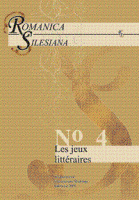Gioco allegorico ne “Le mosche del capitale” di Paolo Volponi
Allegorical Games in Paolo Valponi's "Le mosche del capitale
Author(s): Joanna JanuszSubject(s): Language and Literature Studies
Published by: Wydawnictwo Uniwersytetu Śląskiego
Keywords: Volponi; allegory; postindustrial factory
Summary/Abstract: Paolo Volponi’s last novel, „Le mosche del capitale”, published in 1989, is considered by most critics to be the most important novel of the late eighties. It revisits the issues from the author’s earlier works, for example “Memoriale” (1962) and “Corporale” (1974), and transports the reader into a postindustrial factory world, dealing with the problems of human beings entangled in the complex and often cruel mechanisms of professional life in the contemporary world. Human characters are completely devoid of meaning and any humane dimension. In the pursuit of profit and power, they get so lost that they cease to be the driving force of narration. In this dehumanised world the burden of diegesis is placed on personified objects, which not only talk about the human world from their “inanimate” perspective, but also keep their distance from that world, which is a prerequisite for a reasonably objective depiction of its problems. The narrative, told from the perspective of the main protagonist (engineer Bruto Saraccini), is supplemented by the allegorical characters’ (i.e. objects’ and environmental phenomena’s) utterances. Therefore, allegory in Volponi’s text becomes the basic carrier of meaning. It is thanks to allegory that the reader becomes aware of the void and meaninglessness of the reality in which objects are closer to humanism and humanity than people themselves. Allegory plays three functions in the novel: 1) interpretative-rhetorical, in which human beings’ traits (vices) are projected onto inanimate objects, as a result of which the characteristics of the human world become clearer and more marked; 2) axiological, which explicitly names and establishes the system of values, exposing human characters’ moral attitudes; 3) mimetic, whose aim is to supplement the description of the world depicted in a situation in which human characters are not able to provide such a description in a complete way (e.g. the use of allegorical objects as observers and “narrators” replaces the characters’ inner monologue).
Journal: Romanica Silesiana
- Issue Year: 2009
- Issue No: 4
- Page Range: 138-148
- Page Count: 11
- Language: Italian

